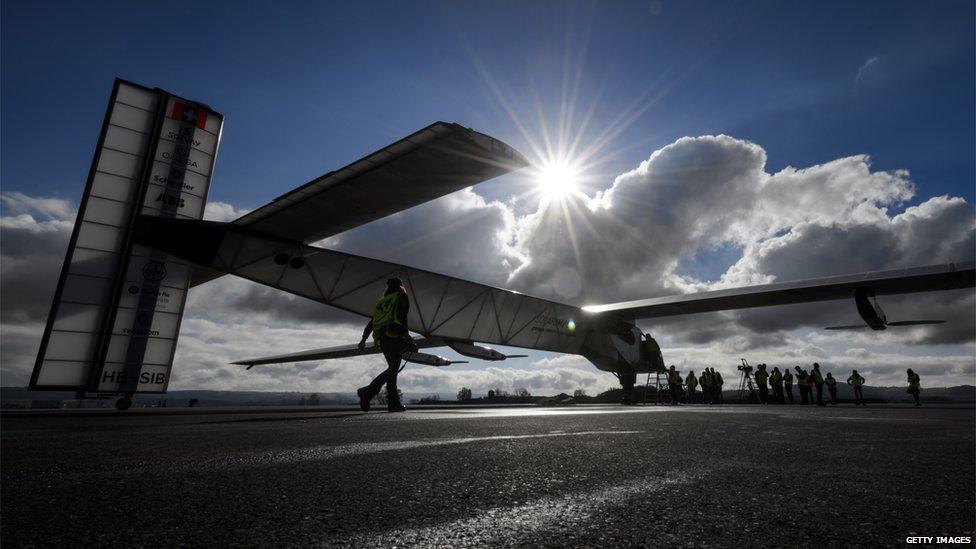How does a solar plane fly at night? Solar Impulse 2 facts
- Published

The Solar Impulse-2 plane takes off for a trip around the world, from Al Bateen Executive Airport in Abu Dhabi
A solar powered plane called Solar Impulse 2, has launched successfully and is now attempting to become the first solar powered flight to travel around the globe.
Solar Impulse 1 has already flown across the United States, storing enough energy from the sun to fly overnight.
Martin reports on Solar Impulse 2's take off
Now, after launching from Abu Dhabi in the Middle East on 9 March, Solar Impulse 2 is aiming to go one better and fly for 25 days, over 5 months, all the way around the Earth.
Abu Dhabi (start)
Oman
India (2 stops)
Myanmar
China (2 stops)
USA (4 stops)
One stop in Southern Europe
Abu Dhabi (finish)
So how will it do it? Read on...
It ain't heavy
Considering its size, Solar Impulse 2 is very light.
It weighs 2.3 tonnes, or 2,300kg, about the same as a standard family car.
With wings 72m wide, the same as a Boeing 747 Jumbo Jet - it's really light, and that allows it to be powered with as little power as possible.
The super-wide wings allow it to take advantage of air currents to glide without the need for much power.
It'll also fly much, much slower than jet planes do - its top speed will be 62mph, 10 times slower than most jets.
So the plane can carry smaller, lighter batteries to store energy at night.
The solar plane is as wide as a Boeing 747 jumbo jet
Better batteries
New technology since the first Solar Impulse plane has also allowed batteries to be much more energy efficient.
Flies between 31-62mph
Will fly for 25 days in total
With stops, journey will take 5 months
Powered by 17,000 solar panels
Is 72m wide
Stopping 12 times
Weighs 2.3 tonnes
Batteries that can allow the plane to fly for hours without any sunlight are now tougher, lighter and much more compact.
Expert pilots
The two pilots who are going to fly the plane on its 25-day, 12-stop flight have plenty of experience too.
Andre Borschberg was the first person to fly for 24 hours on nothing but solar power, back in 2010.
Bertrand Piccard was part of the team that flew around the world non-stop in a balloon.
His grandfather was the first person to climb high enough in a balloon to see that the Earth was curved, with his own eyes.
Two pilots will fly the mission, and they both have lots of experience
Top tech
The very latest technology used in the plane is already being put to use in other areas.
Inside the cockpit, a specially made thermal foam is used to control the temperature - and that has already been used in some fridges.
The wide wings take advantage of air currents to glide without the need for much power
The most important part of the mission is generating enough energy to power the flight not only when it's sunny - but also in the dark.
For that, the wings of Solar Impulse 2 are covered with 17,000 solar panels, which should gather enough energy to save for night-time flying.
- Published9 March 2015
- Published2 June 2014
- Published10 April 2014
